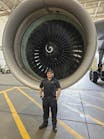Feb. 26--The Federal Aviation Administration (FAA) has prepared an airworthiness directive requiring all Boeing 737 MAXs to be inspected for a manufacturing defect the jet maker discovered in December.
All MAXs found to have the defect will have to be fixed before they can fly again, although Boeing doesn't expect this requirement to add further delay to the aircraft's return to service.
The FAA directive was posted to the Federal Register on Tuesday, a day ahead of formal publication.
The manufacturing defect, which was reported by The Seattle Times and others in January, arose when mechanics working on the final finish of the airplanes, polishing the carbon composite engine pods at the end of the production process, ground away some underlying layers of metal foil in the upper part of the pod that are necessary for lightning protection.
The error leaves the engine pods, called nacelles, vulnerable to a lightning strike, "which could potentially lead to a dual engine power loss event," the FAA directive states.
If not addressed, the condition could result in a forced landing away from an airport "due to loss of thrust control on both engines," the FAA added.
The work required to fix the issue is just 12 hours per airplane -- five hours to do the inspection and a further seven hours if a fix is required, the FAA estimated.
Boeing spokesman Bernard Choi said Tuesday that the company is "coordinating with our customers to complete the work prior to safe return to service."
He added that Boeing's projection that the MAX should be cleared to fly by midsummer is not affected by this additional work, which can be done while the planes are on the ground awaiting approval of the design updates. "We've not changed our estimate for return to service," Choi said.
The fix for the defect requires replacement of two carbon composite fairing panels that cover the area where the engine pod hangs from the strut that connects it to the wing. Operators will also have to apply a sealant to establish a required electrical bond path to safely disperse any lightning strike.
The FAA describes the defect as arising out of "excessive rework of the surface of the metallic (aluminum foil) inner layer of those panels (that) can result in cuts to that layer." The metal foil serves as a shield against a surge of electrical current.
Without it, the FAA's directive states, lightning could "induce spurious signals onto the underlying airplane wiring, including wiring associated with the engine control systems," which could cause a loss of thrust control to one or both engines.
When Boeing discovered the manufacturing problem, it alerted airline operators in December that inspections of certain MAXs built in the past year should be completed within six months, and fixes made as required.
The FAA, however, is insisting that all of the roughly 800 MAXs built so far be inspected, and where necessary fixed "before further flight." Boeing will have to cover all the costs under warranty.
(c)2020 The Seattle Times
Visit The Seattle Times at www.seattletimes.com
Distributed by Tribune Content Agency, LLC.



